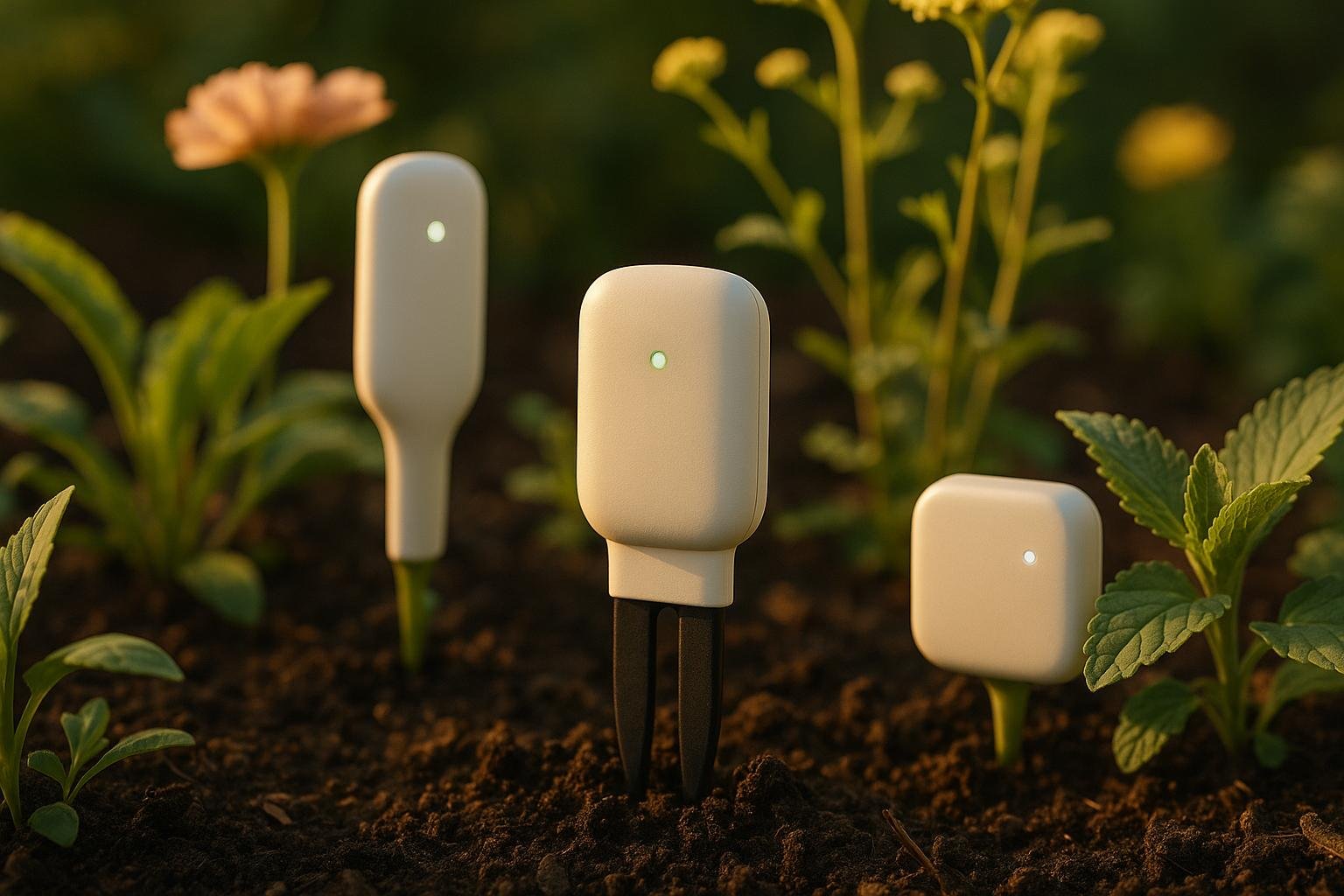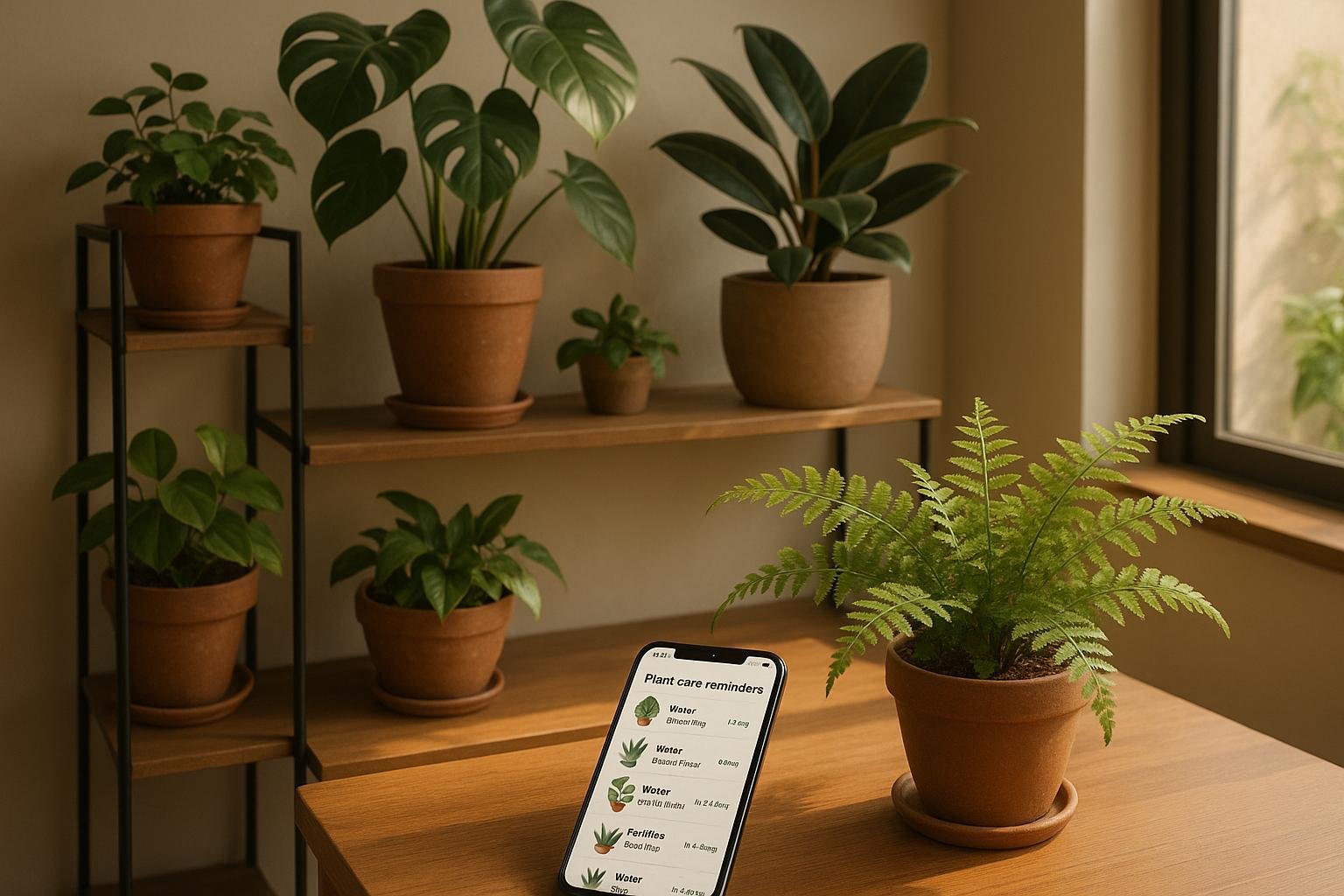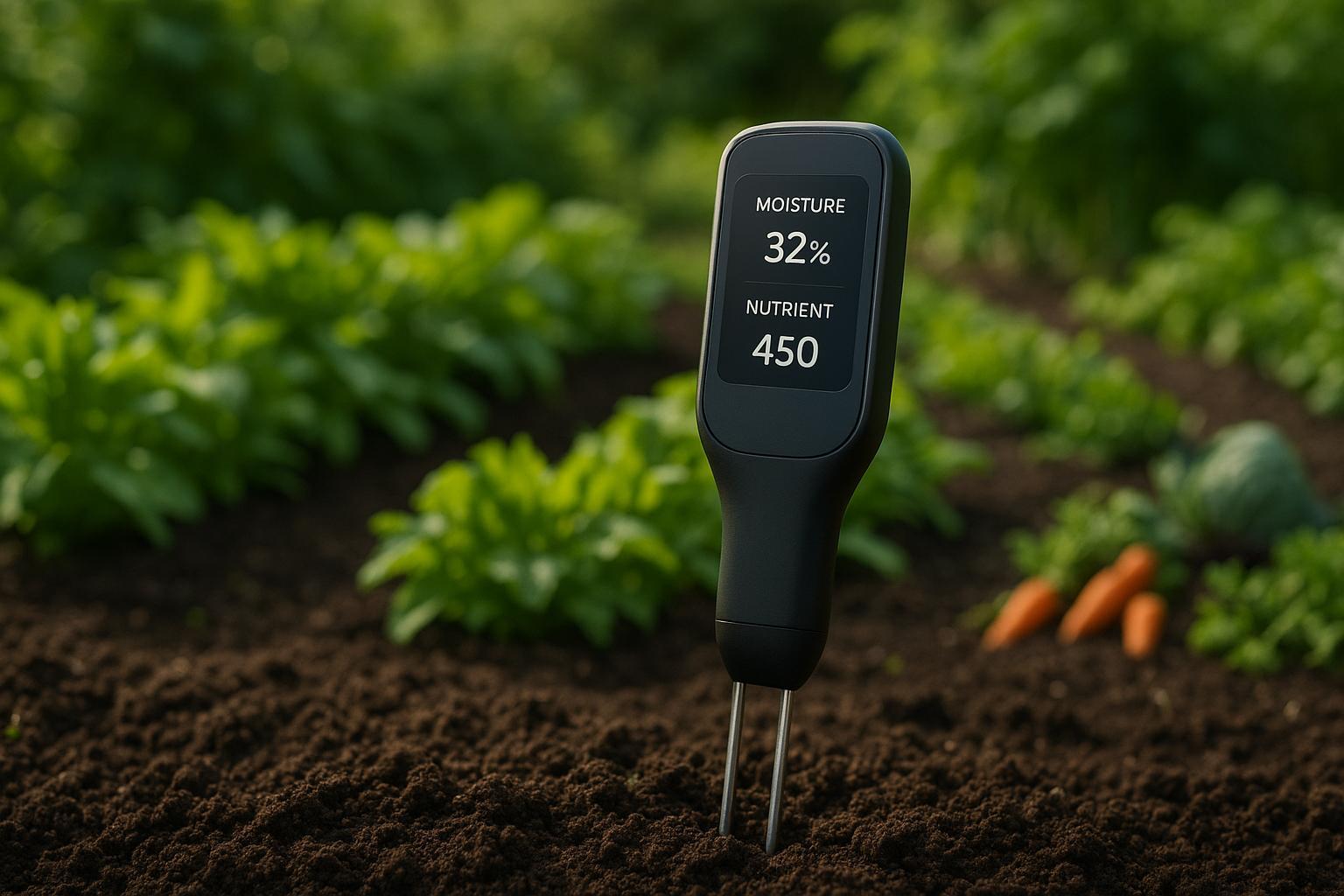Top 5 Data Compression Methods for IoT Sensors

IoT sensors generate massive amounts of data, and managing it efficiently is critical. Here are the top 5 data compression methods tailored for IoT garden monitoring systems:
- Zstandard (Zstd): High-speed, lossless compression with up to 70% data reduction and energy-efficient real-time performance. Ideal for structured, repetitive garden data like soil moisture and temperature readings.
- Adaptive Huffman with Deep Learning: Combines neural networks with Huffman coding for dynamic, pattern-based compression. Reduces data by up to 59%, perfect for evolving sensor data.
- Two-Layered Compression Approach: Sequentially applies two algorithms for deeper data reduction. Balances energy use and processing delays, cutting transmission energy by up to 40%.
- Differential Pulse Code Modulation (DPCM): Focuses on differences between data points, offering up to 80% data reduction with minimal computational demands. Best for gradual changes in garden data like temperature or soil moisture.
- Time Series Compression: Analyzes predictable trends in temporal data for up to 90% compression. Optimized for long-term storage and real-time monitoring of environmental patterns.
Quick Comparison Table:
| Method | Compression Efficiency | Processing Speed | Energy Use | Best For |
|---|---|---|---|---|
| Zstandard (Zstd) | Up to 70% | High | Low | Structured, repetitive data |
| Adaptive Huffman + Deep Learning | Up to 59% | Moderate | Low | Evolving, pattern-based data |
| Two-Layered Compression | Up to 69%+ | Moderate | Moderate | Continuous, predictable streams |
| Differential Pulse Code Modulation (DPCM) | Up to 80% | Very High | Very Low | Gradual changes in sensor data |
| Time Series Compression | Up to 90% | High | Low | Long-term environmental patterns |
Efficient data compression is essential for real-time garden monitoring, energy savings, and bandwidth optimization. Keep reading to learn how these methods can transform your IoT systems.
The Science and Application of Data Compression Algorithms

1. Zstandard Algorithm
The Zstandard algorithm, or Zstd, is a high-speed, real-time compression tool that's particularly effective for IoT garden monitoring systems. It’s designed to handle the challenges of transmitting data in resource-limited environments.
One of Zstd’s standout features is its dictionary compression mode, which is perfect for the small data packets generated by sensors. Whether it’s soil moisture levels, temperature readings, or pest activity, Zstd compresses these packets efficiently, offering excellent compression ratios while maintaining real-time performance.
Compression Efficiency: Balancing Ratio and Accuracy
In real-world IoT scenarios, Zstd can compress up to 70% of the original data. For structured sensor data, it achieves a compression ratio of 2.79 using a 32kB history window. This makes it highly effective for garden monitoring systems, where data is often structured and repetitive.
Zstd also offers 22 levels of compression, allowing users to adjust the balance between compression ratio and speed based on their needs. For example, text-heavy data like pest logs or plant health reports can be compressed efficiently without losing any information, thanks to Zstd’s lossless compression approach.
Real-Time Performance: Minimal Delays
What sets Zstd apart is its real-time capability. Tests with IoT sensor networks showed a throughput of 85.43 bytes per millisecond and a fog processing delay of just 6.25 milliseconds when handling data from 100 sensors. This level of speed is crucial for time-sensitive applications like garden monitoring.
On the receiving end, Zstd’s fast decoder ensures that compressed data is quickly processed - whether you’re accessing it on a smartphone or through a cloud-based garden management system. This means you get critical updates and notifications without unnecessary delays.
Energy Efficiency: Extending Battery Life
Zstd isn’t just fast - it’s also energy-efficient. Its low computational overhead helps conserve battery life for sensors and reduces the energy required for data transmission. For remote garden setups where replacing batteries often isn’t feasible, this energy efficiency is a game-changer.
Perfect Fit for Garden IoT Data
Garden monitoring systems produce a mix of data types, from numerical sensor readings to text-based reports. Zstd excels in compressing both. For example, its ability to handle text data makes it ideal for transmitting pest identification logs or plant health assessments. Plus, compatibility with programming languages like Java, Python, and Rust ensures seamless integration with various IoT platforms and devices.
Whether you’re working with a Raspberry Pi setup or commercial garden sensor hardware, Zstd can easily fit into your system. Its ability to manage multiple sensor streams efficiently makes it a reliable choice for comprehensive garden monitoring, delivering real-time insights with minimal delay and energy use.
2. Adaptive Huffman with Deep Learning
Adaptive Huffman with Deep Learning combines neural networks with Huffman coding to adapt in real-time to changing sensor data from gardens. Unlike static methods, which rely on fixed data patterns, this approach dynamically adjusts as sensor readings shift due to weather, seasonal changes, or plant growth.
By integrating neural networks, this method enhances traditional Huffman coding. Instead of focusing solely on symbol frequencies, it uses pattern recognition and learned weights, resulting in better compression rates.
Compression Efficiency: Tailored to Your Garden's Data
Tests conducted at six Malaysian air quality stations revealed that Huffman coding enhanced by deep learning (HDC) reduces data by 58–62%. For comparison, traditional Adaptive Huffman and LZW methods achieved reductions of 49–51% and 44–46%, respectively. This means HDC is about 1.4 times more effective. For garden monitoring systems, this translates to shrinking data sizes by up to 59%. The algorithm's success depends heavily on its ability to identify patterns within each sliding window of data.
Processing Delay: Finding the Right Balance
While the addition of deep learning improves compression efficiency, it also increases computational demands. The HDC algorithm uses sliding windows to quickly identify and compress recurring patterns. This design strikes a balance between intelligence and speed, ensuring timely updates for garden monitoring systems.
Energy Consumption: Smarter Use of Power
Energy efficiency is critical for IoT devices. Transmitting a single bit of data via radio consumes 480 times more energy than performing a basic addition operation. By reducing the amount of transmitted data, HDC helps conserve energy. The algorithm operates with less than 80 KB of IoT memory and uses a maximum of 44 mAmps per compression cycle. Techniques like pruning and pooling further streamline the Huffman tree, enabling the algorithm to run efficiently on sensors with limited resources.
Perfect Fit for Garden IoT Sensor Data
Efficient compression is crucial for real-time analysis of garden data. Systems like Zstandard have shown how effective compression supports data-heavy applications. Garden monitoring generates diverse time-series data, such as daily temperature fluctuations, soil moisture levels, and humidity changes. Adaptive Huffman with Deep Learning excels at identifying and compressing these numeric patterns. Over time, as more data is collected, the deep learning component becomes better at recognizing recurring trends, reducing the need for data transmission and conserving energy.
These benefits are invaluable for modern garden management. Platforms like AIGardenPlanner, which integrate AI-powered analytics for garden design and monitoring, can leverage this adaptive compression to optimize real-time data handling and improve overall system efficiency.
🚀 Ready to Reinvent Your Garden?
Join thousands of homeowners who have transformed their gardens using our AI design tool. Upload one photo to explore endless possibilities.
Get your AI garden designs →3. Two-Layered Compression Approach
The two-layered compression approach uses two different algorithms in sequence to achieve greater data reduction. The first algorithm tackles obvious redundancies, while the second focuses on more subtle patterns. This combination not only compresses data more effectively but also ensures its integrity, making it an efficient solution for systems like garden monitoring, which produce continuous streams of sensor data.
By pairing algorithms with complementary strengths, this method creates smaller, more efficient data packets. This is especially useful for real-time garden monitoring, where managing constant data flow is critical.
Compression Efficiency: Strength in Layers
This approach stacks two algorithms to maximize compression. For instance, a study in 2023 by de Oliveira Júnior et al. showed that the LZW algorithm alone achieved a 69% compression rate for temperature data in LoRa networks. Adding a second compression layer can push these results even further.
Garden sensors typically generate predictable patterns in data, such as temperature, humidity, and soil moisture readings. The first algorithm removes the obvious redundancies, while the second identifies and compresses more intricate patterns. This layered strategy ensures that even subtle trends in the data are captured, boosting overall efficiency.
Processing Delay: Finding the Right Balance
While two-layered compression increases processing time, careful selection of compatible algorithms can minimize delays. This balance is crucial for real-time garden monitoring, where timely transmission of sensor data is essential for issuing alerts and updates.
Energy Consumption: Extending Sensor Lifespan
One of the biggest advantages of this approach is its impact on energy use. Data transmission can account for up to 60% of a device's energy consumption. By compressing data more effectively, the volume of transmitted data decreases, which directly reduces energy usage.
In 2021, Al-Kadhim & Al-Raweshidy demonstrated that adaptive compression schemes could cut power consumption by an average of 40%, potentially extending device lifespan by up to 50%. Although dual-layered compression uses slightly more processing power, the reduction in transmission energy more than offsets this, making it ideal for battery-powered, remote garden sensors.
Perfect Fit for Garden IoT Sensors
Garden monitoring systems are particularly well-suited for two-layered compression due to the predictable nature of their data. Temperature changes, soil moisture levels, and humidity readings often follow regular patterns, such as daily and seasonal cycles. The first compression layer handles the immediate, repetitive data, while the second digs deeper into broader trends.
This dual-layered method enables garden management platforms to efficiently handle larger sensor networks without driving up transmission costs. It’s an effective way to manage the constant flow of data while keeping energy use and operational expenses in check.
4. Differential Pulse Code Modulation
Differential Pulse Code Modulation (DPCM) takes a unique approach to data compression by focusing on changes between data points instead of storing absolute values. This method is particularly effective for IoT sensors, like those used in garden monitoring, as it leverages the strong correlation between consecutive readings.
Rather than recording full readings (e.g., 72°F, 73°F, 72°F), DPCM stores the initial value followed by the differences (+1, -1). This small shift drastically cuts down the amount of transmitted data, making it a highly efficient compression technique.
"Taking advantage of the high correlation which usually occurs between successive samples captured by IoT sensor nodes and using the entropy principle in compression, a simple lossless algorithm for compression built on Differential Pulse Code Modulation (DPCM) was suggested in this paper, that is especially useful for IoT sensor nodes that characterized by reduced memory and computational resources." - Ali Kadhum M. Al-Qurabat, Al-Mustaqbal University
Compression Efficiency: Smarter Data Management
DPCM shines when applied to garden sensor data, which typically changes gradually over time. Research shows that it outperforms traditional methods like Huffman encoding by reducing data volume while demanding less computational power. This efficiency stems from its ability to capture predictable patterns in environmental data.
For example, soil moisture levels don't spike from 20% to 80% within moments, and temperature changes tend to follow smooth, gradual trends. DPCM captures these predictable shifts effectively, compressing data into smaller packets while maintaining accuracy, as it is a lossless compression method.
Processing Delay: Keeping Real-Time Monitoring Intact
One of DPCM's biggest advantages is its simplicity and speed. The algorithm only calculates differences between consecutive values, requiring minimal processing power. This makes it ideal for battery-powered garden sensors with limited resources. Since it processes data quickly, it avoids delays, ensuring real-time monitoring remains uninterrupted.
This speed is crucial for garden monitoring systems, which often need to react to changes in soil moisture or temperature without delay. DPCM ensures your data pipeline remains smooth and responsive, even during sudden environmental shifts.
Energy Consumption: Prolonging Sensor Battery Life
DPCM helps conserve energy in two key ways. First, by reducing the amount of data that needs to be transmitted - an essential factor since transmitting a single bit of data consumes far more energy than processing it locally. Second, its low computational demands further minimize energy use.
Studies highlight the energy-saving potential of DPCM-based solutions. For example, a similar compression method reduced transmitted data by 69–80% and energy consumption by 73–77%. These savings directly translate into longer battery life for remote garden sensors, a critical benefit for maintaining long-term monitoring systems.
Best Fit for Garden IoT Sensor Data
Garden monitoring applications are a perfect match for DPCM compression. Environmental sensors used for tracking temperature, soil moisture, and humidity generate data that changes gradually - exactly the type of data where DPCM excels. For these scenarios, DPCM provides an optimal balance of efficient compression and low computational complexity.
That said, DPCM is less suited for sensors that deal with rapidly fluctuating data, such as wind speed or sudden event detection. In such cases, other compression methods might perform better. However, for most garden monitoring needs - like tracking temperature, humidity, soil conditions, and light levels - DPCM offers a practical and efficient solution.
sbb-itb-4d6a8dd
5. Time Series Compression
Time series compression is a smart way to manage temporal data, especially in garden monitoring systems. It works by analyzing sequences of sensor data to identify predictable trends, reducing the data size while keeping all the key information intact.
Environmental data, like temperature shifts, soil moisture levels, and light intensity, often follow gradual and predictable patterns. By recognizing these trends, time series compression helps cut down on storage needs and improves data transmission. This makes it possible to archive sensor data spanning days, months, or even years without overwhelming storage systems or networks. Essentially, it uses the natural predictability of environmental changes to make storage and communication more efficient.
Compression Efficiency: Better Storage and Faster Transmission
Time series compression delivers impressive results when it comes to storage and transmission. For instance, TimescaleDB, a popular open-source time-series database, boasts over 90% lossless compression rates. This translates into major savings on storage costs. Similarly, XOR-based techniques achieve remarkable compression by reducing over 50% of floating-point values to a single bit, about 30% to 26.6 bits, and the remainder to roughly 39.6 bits. These methods excel at handling the slow, time-based changes typical of garden sensor data.
Processing Delay: Real-Time Monitoring Made Simple
Speed is crucial in garden monitoring, where sensors often trigger automated systems like irrigation or alerts. Time series compression optimizes decoding processes, enabling query responses up to 40 times faster than traditional LZ-based methods. This ensures that monitoring systems can process sensor data quickly and respond to environmental changes in real time, keeping gardens healthy and systems efficient.
Energy Consumption: Extending Sensor Lifespan
For battery-powered garden sensors, energy efficiency is a top priority. Compressing data reduces the volume that needs to be transmitted, significantly cutting communication energy costs. Research shows that this can extend device lifespans considerably. In real-world applications, dynamic monitoring algorithms have saved sensors more than 9 hours of battery life daily. Additionally, adaptive frameworks have reduced data volume and energy use by about 70%, all while maintaining high levels of accuracy. These advancements lower maintenance efforts and make sensor operations more sustainable.
Perfect Fit for Garden IoT Data
Garden monitoring systems are an ideal match for time series compression. Sensors that track temperature, humidity, soil moisture, and light levels generate data streams with predictable patterns and redundancies. Compression ensures these data streams are managed efficiently, keeping systems responsive and cost-effective. This approach is a cornerstone of modern garden monitoring, seamlessly integrating into IoT architectures like AIGardenPlanner to deliver reliable and efficient performance.
How These Methods Work in Garden Monitoring
Garden monitoring systems leverage IoT sensors to keep tabs on soil moisture, temperature, pest activity, and overall plant health. These sensors generate a significant amount of data, which needs to be transmitted efficiently to central systems. That's where data compression comes in - it makes the process more cost-effective and energy-efficient, especially when quick action is required.
Pest Detection and Disease Tracking benefit greatly from compressed data transmission. For instance, when sensors pick up patterns in temperature, humidity, or soil conditions that suggest pest infestations or plant diseases, they can instantly alert gardeners or automated systems. This rapid communication is critical since such issues can wreak havoc on large sections of a garden in mere hours.
Real-time monitoring becomes far more effective with efficient compression techniques. Some algorithms can compress data up to 24.7 times more than raw formats while slashing energy consumption by as much as 94% compared to uncompressed transmission. This efficiency allows sensors to continuously send detailed environmental updates without overloading network bandwidth or draining their batteries too quickly.
AIGardenPlanner utilizes compressed sensor data to refine its design recommendations based on live garden conditions. For example, IoT sensors spread throughout a garden can transmit compressed data about soil quality, sunlight exposure, and moisture levels. The platform processes this information quickly, enabling more precise plant recommendations tailored to the garden's specific needs rather than relying on general climate trends.
Bandwidth optimization is vital for gardens in rural areas where internet connectivity may be limited. Compression algorithms shrink data packets sent between devices and servers, conserving bandwidth and resources. For example, the LZW algorithm achieves a 69% compression rate for temperature data while reducing energy consumption by up to 22%. Since data transmission accounts for up to 60% of an IoT device’s energy use, compression can cut that by as much as 40%, extending the life of sensors by up to 50%. This level of efficiency ensures that monitoring systems remain functional even with limited bandwidth.
Efficiency in data handling also enables advanced analytics. AI integration with compression methods is becoming increasingly common in garden monitoring. By using machine learning, systems can prioritize the most critical data points for plant health. For example, signs of plant stress or disease symptoms are transmitted with minimal compression for accuracy, while routine environmental data is compressed more heavily.
Compressed data enhances both AI-driven insights and automated irrigation systems. For instance, when soil moisture sensors detect dryness, compressed data ensures that irrigation systems receive activation signals almost instantly. By optimizing compression ratios, these systems can improve the Age of Information (AoI), reducing data delays by up to 82%. This means irrigation happens exactly when needed, preventing plant stress and conserving water.
For professionals, compressed data streams are a game-changer. AIGardenPlanner’s commercial features allow landscapers and garden designers to monitor multiple garden sites simultaneously without overwhelming data networks. This capability enables professionals to track plant establishment, identify maintenance needs, and adjust care schedules based on real-time sensor feedback rather than relying on estimated timelines.
🎨 Visualize Your Dream Garden Today!
Transform any outdoor space into a professional landscape design in minutes. Just upload a photo, choose your style, and let our AI do the rest.
Start your garden transformation now →Conclusion
Advanced data compression techniques have transformed the functionality of IoT sensors in garden monitoring systems, driving improvements in efficiency and performance. These methods tackle key challenges in modern smart gardening by cutting energy use, speeding up data transmission, and maintaining data integrity.
Data transmission alone can consume up to 60% of the total energy used by IoT devices. Compression techniques help reduce this energy demand by an average of 40%, which can extend battery life by as much as 50%. This means fewer battery replacements and more dependable systems that require minimal upkeep while running continuously.
Beyond energy savings, real-time monitoring sees significant benefits through optimized compression. Advanced algorithms enable faster response times for critical garden events like detecting pests, identifying irrigation needs, or spotting signs of disease.
Striking the right balance between data accuracy and transmission efficiency is crucial. Lossless compression ensures precise measurements for critical metrics like soil pH and nutrient levels, while lossy compression works well for routine environmental data where slight variations are acceptable. For instance, soil moisture sensors in smart agriculture can use lossy compression to send approximate readings without compromising irrigation decisions.
These techniques don’t just preserve data accuracy - they also streamline network resource usage. Compression can reduce storage demands by up to 49% and significantly lower bandwidth requirements during data transmission. This efficiency becomes vital as garden monitoring systems grow more complex.
Platforms like AIGardenPlanner harness these advancements to process sensor data in real time, enabling quicker analysis and more responsive design suggestions. By handling multiple data streams efficiently, the system maintains high performance while keeping operational costs in check.
To get the most out of IoT technology in garden data analytics, professionals need to choose compression methods tailored to specific data needs. Whether the goal is extending battery life for remote sensors or ensuring precise data for monitoring plant health, selecting the right compression strategy is key to unlocking the full potential of smart gardening systems.
FAQs
How do data compression methods affect the battery life of IoT sensors in garden monitoring systems?
The Role of Data Compression in Extending IoT Sensor Battery Life
Data compression techniques are essential for improving the battery life of IoT sensors used in garden monitoring systems. By cutting down the volume of data that needs to be sent, these methods reduce the energy required for wireless communication - one of the most power-hungry operations for IoT devices.
Take temporal compression, for instance. It reduces how often data is transmitted, which directly lowers energy consumption. Similarly, algorithms like Huffman coding make data storage and transmission more efficient without sacrificing accuracy. These approaches can sometimes slash energy usage by as much as 40%, dramatically extending the lifespan of battery-powered sensors. Employing smart compression methods not only helps save battery power but also keeps garden monitoring systems running smoothly in real time.
What are the challenges of balancing data compression and real-time processing in IoT garden monitoring?
Balancing data compression with real-time processing is crucial for the smooth operation of IoT garden monitoring systems. Efficient data compression minimizes the amount of transmitted data, conserving both bandwidth and energy - an essential factor in resource-constrained environments like gardens. Techniques such as Huffman coding or LZW are widely used for this purpose, ensuring data accuracy while reducing its size.
That said, higher compression levels can sometimes lead to delays, impacting the system's real-time responsiveness. This becomes particularly critical for tasks like tracking soil moisture or temperature, where immediate feedback is essential. Striking the right balance between compression efficiency and processing speed is key to maintaining a system that operates effectively without sacrificing responsiveness.
How does the choice of data compression method impact the accuracy of environmental data from IoT sensors?
The method you use to compress data can have a big impact on the accuracy of information gathered by IoT sensors. Lossy compression is great for significantly reducing file sizes, but it comes at a cost - it may strip away some details. This can lead to inaccuracies in areas like smart farming or environmental monitoring, where even small data gaps could result in less dependable insights for making decisions.
In contrast, lossless compression keeps all the original data intact, ensuring both precision and reliability. This makes it an ideal choice for tasks that demand high accuracy, such as real-time monitoring or predictive analytics. Choosing the right compression method means finding the right balance between saving storage space and preserving the quality of your data.
Related posts
Related Articles

Top 5 AI Apps for Plant Care Reminders
Explore the top 5 AI apps that simplify plant care with personalized reminders, health diagnostics, and tailored advice for every gardener.

Top 7 Soil Sensors for Moisture and Nutrient Tracking
Explore the top soil sensors for monitoring moisture and nutrients, enhancing your gardening efficiency and plant health.

5 Steps to Merge AI with Cottage Garden Design
Integrate AI into your cottage garden design process with five essential steps for a beautiful and practical outdoor space.

AI Tools for Designing Snow-Themed Gardens
Learn how AI tools simplify the creation of enchanting snow-themed gardens tailored to your climate and design preferences.

Checklist for Zen Garden Structure Maintenance
Explore essential maintenance tasks to preserve the serene beauty of your Zen garden, ensuring its tranquility and vibrant health.

AI Holiday Lighting for Landscapers
Explore how AI is revolutionizing holiday lighting for landscapers, enhancing design efficiency, customization, and client satisfaction.